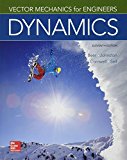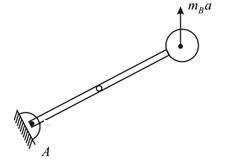
Concept explainers
(a)
Magnitude of maximum angular velocity of bar
Answer to Problem 19.107P
The maximum angular velocity of bar AB is
Explanation of Solution
Given:
Mass of attached sphere is
Spring constant is
Vertical deflection is
Maximum amplitude of deflection is
Frequency of rotation is
Concept used:
Draw the FBD for bar AB in equilibrium state.

After giving small deflection to bar AB, Draw FBD of bar AB

Draw the equivalent kinetic diagram for bar AB as.

Write the expression for displacement of point C in terms of angular displacement.
Here,
Write the expression for displacement of point B in terms of angular displacement.
Here,
Substitute
Take moment about point A for equilibrium position.
For static equilibrium substitute
Simplify the above expression.
Here,
Take moment about point A after giving the angular displacement.
Substitute
Substitute
Substitute
Substitute
Substitute
Rearrange the above expression as.
Here,
Write the standard equation of motion as.
Compare the coefficient of
Compare the coefficient of
Write the expression for maximum amplitude of force.
Here,
Write the expression for natural frequency of system.
Here,
Write the expression for the amplitude of vibration of sphere B.
Here,
Write the expression for magnitude of maximum angular velocity of bar AB.
Here,
Calculation:
Substitute
Substitute
Substitute
Substitute
Substitute
Substitute
The maximum angular velocity of bar AB is
Conclusion:
Thus, the maximum angular velocity of bar AB is
(b)
Magnitude of maximum acceleration of sphere
Answer to Problem 19.107P
The maximum acceleration of sphere is
Explanation of Solution
Concept used:
Write the expression for maximum acceleration of sphere.
Here,
Calculation:
Substitute
The maximum acceleration of sphere is
Conclusion:
Thus, the maximum acceleration of sphere is
Want to see more full solutions like this?
Chapter 19 Solutions
Package: Vector Mechanics For Engineers: Dynamics With 1 Semester Connect Access Card
- A 48-kg advertising panel of length 2a = 2.4 m and width 2b = 1.6 m is kept rotating at a constant rate w1 about its horizontal axis by a small electric motor attached at A to frame ACB. This frame itself is kept rotating at a constant rate w2 about a vertical axis by a second motor attached at C to the column CD. Knowing that the panel and the frame complete a full revolution in 6 s and 12 s, respectively, express, as a function of the angle 0, the dynamic reaction exerted on column CD by its support at D.arrow_forwardA 1.6-kg tube AB can slide freely on rod DE which in turn can rotate freely in a horizontal plane. Initially the assembly is rotating with an angular velocity of magnitude w = 5 rad/s and the tube is held in position by a cord. The moment of inertia of the rod and bracket about the vertical axis of rotation is 0.30 kg.m2 and the centroidal moment of inertia of the tube about a vertical axis is 0.0025 kg.m2If the cord suddenly breaks, determine (a) the angular velocity of the assembly after the tube has moved to end E, (b) the energy lost during the plastic impact at E.arrow_forwardTwo blocks each have a mass 1.5 kg and are attached to links that are pin-connected to bar BC as shown. The masses of the links and bar are negligible, and the blocks can slide without friction. Block D is attached to a spring of constant = 720 N/m. Knowing that bloc k = 720 N/m. Knowing that block A is at rest when it is struck horizontally with a mallet and given an initial velocity of 250 mm/s, determine the magnitude of the maximum displacement of block D during the resulting motion.arrow_forward
- The ABC bar has a mass of 2.4 kg and is connected to a support on B. An 800 g D sphere reaches the end A of the bar with a vertical velocity v1 of 3 m / s. Knowing that L = 750 mm and that the coefficient of refund between the sphere and the ABC bar is equal to 0.5, determine immediately after the shock, the angular velocity of the ABC bar and the velocity of the sphere.arrow_forwardA locomotive consists of multi cylinder reciprocating engine running at a speed of 8 r.p.s having a stroke length of 29cm, which carries a mass of reciprocating part whose magnitude is 11kgs with a revolving part of 5kgs rotating at 17cm radius. If two third of the reciprocating parts and all the revolving parts are to be balanced, determine the following when the crank has rotated 500 from top dead centre to bottom dead centre. solve 4 and 5 1. Maximum primary unbalanced force of reciprocating mass in newtons 2. Balancing mass required at a radius of 41cm in kgs 3. Variation of maximum & minimum tractive force in newtons 4. Variation of maximum & minimum swaying couple for the given centre distance 76cm between the two cylinders in (N-m) 5. Magnitude…arrow_forwardInside a machine, two gears, A and B, HINGED at their centers, are meshed with each other such that gear A transmits torque and speed to gear B. Gear A has a mass mA=2 kg, radius rA=175 mm, and radius of gyration kA=150 mm. Gear B has a mass B=5 kg, radius rB=525 mm, and radius of gyration kB=400 mm. From rest, a counter-clockwise couple M of constant magnitude 6 Nm is applied to Gear A. Which of the following is closest to the magnitude of the angular acceleration of gear B, in radians per square seconds (rad/s2)?3.0044.814.9445.6arrow_forward
- A 255-lbf block is suspended from an inextensible cable which is wrapped around a drum of 1.75-ft radius rigidly attached to a flywheel. The drum and flywheel have a combined centroidal moment of inertia 12 lb . ft . s 2 . At the instant shown, the velocity of the block is unknown directed downward. Knowing that the bearing at A is poorly lubricated and that the bearing friction is equivalent to a couple M of magnitude 65 lb .ft, determine the velocity of the block before it has moved 3.5 ft downward if at S2 speed is 13.5ft/sarrow_forwardA flywheel connected to a punching machine has to supply energy of 400 Nm while running at a mean angular speed of 20 radians/s. If the total fluctuation of speed is not to exceed ±2%, the mass moment of inertia of the flywheel in kg – m2 isarrow_forwardA semicircular panel with a radius r is attached with hinges to a circular plate with a radius r and initially is held in the vertical position as shown. The plate and the panel are made of the same material and have the same thickness. Knowing that the entire assembly is rotating freely with an initial angular velocity of w0 , determine the angular velocity of the assembly after the panel has been released and comes to rest against the plate.arrow_forward
- A flywheel is a mechanical device used to store rotational kinetic energy for later use. Consider a flywheel in the form of a uniform solid cylinder rotating around its axis, with moment of inertia I = 1/2 mr2. 1) Consider a scenario in which the flywheel described in part (a) (r1 = 0.55 m, mass m1 = 16 kg, v = 45 m/s at the rim) is spinning freely at its maximum speed, when a second flywheel of radius r2 = 2.8 m and mass m2 = 11 kg is coaxially dropped from rest onto it and sticks to it, so that they then rotate together as a single body. Calculate the energy, in joules, that is now stored in the wheel. 2) Return now to the flywheel of part (a), with mass m1, radius r1, and speed v at its rim. Imagine the flywheel delivers one third of its stored kinetic energy to car, initially at rest, leaving it with a speed vcar. Enter an expression for the mass of the car, in terms of the quantities defined here.arrow_forwardProblem 1: In a four bar mechanism, the dimensions of the links are as given below: AB = 50 mm, BC = 66 mm CD = 56 mm and AD = 100 mm At a given instant when |DAB 60o the angular velocity of link AB is 10.5 r/s in CCW direction. Determine, i) Velocity of point C ii) Velocity of point E on link BC when BE = 40 mm iii) The angular velocity of link BC and CD iv) The velocity of an offset point F on link BC, if BF = 45 mm, CF = 30 mm and BCF is read clockwise. v) The velocity of an offset point G on link CD, if CG = 24 mm, DG = 44 mm and DCG is read clockwise. vi) The velocity of rubbing of pins A, B, C and D. The ratio of the pins are 30 mm, 40 mm, 25 mm and 35 mm respectively.arrow_forwardA truck with four wheels, each 750 mm diameter, travels on rails round a curve of 75 m at a speed of 50 km/h. The total mass of the truck is 5 t and its centre of gravity is midway between the axles, 1.05 m above the rails and midway between them. Each pair of wheels is driven by a motor rotating in the opposite direction to the wheels and at four times the speed. The moment of inertia of each pair of wheels is 15 Kgm2. The rails lie on a horizontal plane and 1.45 m apart. Determine the load on each rail.arrow_forward
 Elements Of ElectromagneticsMechanical EngineeringISBN:9780190698614Author:Sadiku, Matthew N. O.Publisher:Oxford University Press
Elements Of ElectromagneticsMechanical EngineeringISBN:9780190698614Author:Sadiku, Matthew N. O.Publisher:Oxford University Press Mechanics of Materials (10th Edition)Mechanical EngineeringISBN:9780134319650Author:Russell C. HibbelerPublisher:PEARSON
Mechanics of Materials (10th Edition)Mechanical EngineeringISBN:9780134319650Author:Russell C. HibbelerPublisher:PEARSON Thermodynamics: An Engineering ApproachMechanical EngineeringISBN:9781259822674Author:Yunus A. Cengel Dr., Michael A. BolesPublisher:McGraw-Hill Education
Thermodynamics: An Engineering ApproachMechanical EngineeringISBN:9781259822674Author:Yunus A. Cengel Dr., Michael A. BolesPublisher:McGraw-Hill Education Control Systems EngineeringMechanical EngineeringISBN:9781118170519Author:Norman S. NisePublisher:WILEY
Control Systems EngineeringMechanical EngineeringISBN:9781118170519Author:Norman S. NisePublisher:WILEY Mechanics of Materials (MindTap Course List)Mechanical EngineeringISBN:9781337093347Author:Barry J. Goodno, James M. GerePublisher:Cengage Learning
Mechanics of Materials (MindTap Course List)Mechanical EngineeringISBN:9781337093347Author:Barry J. Goodno, James M. GerePublisher:Cengage Learning Engineering Mechanics: StaticsMechanical EngineeringISBN:9781118807330Author:James L. Meriam, L. G. Kraige, J. N. BoltonPublisher:WILEY
Engineering Mechanics: StaticsMechanical EngineeringISBN:9781118807330Author:James L. Meriam, L. G. Kraige, J. N. BoltonPublisher:WILEY





